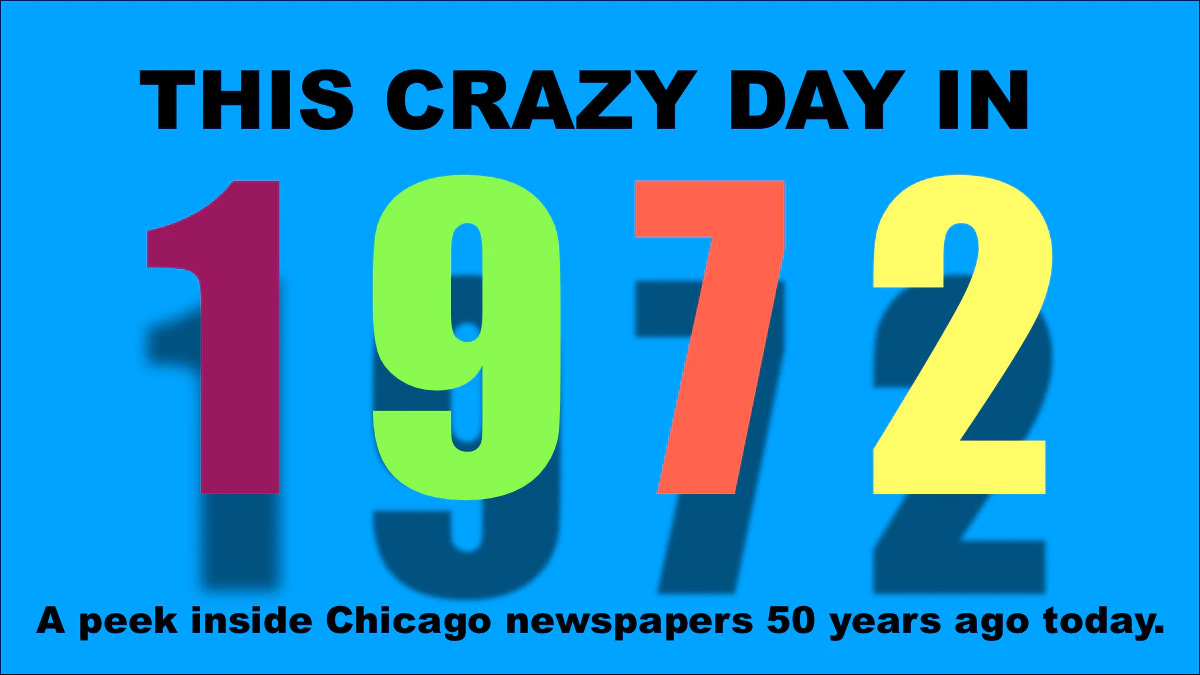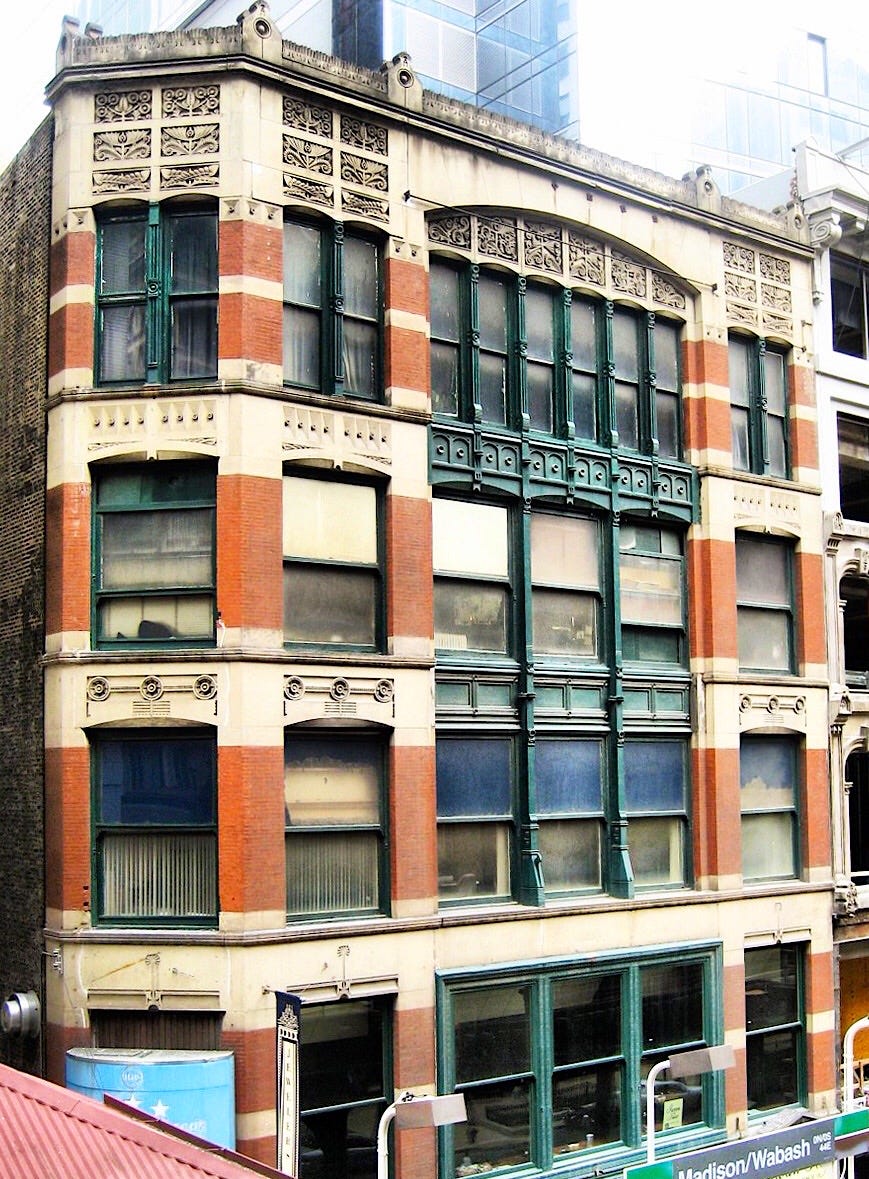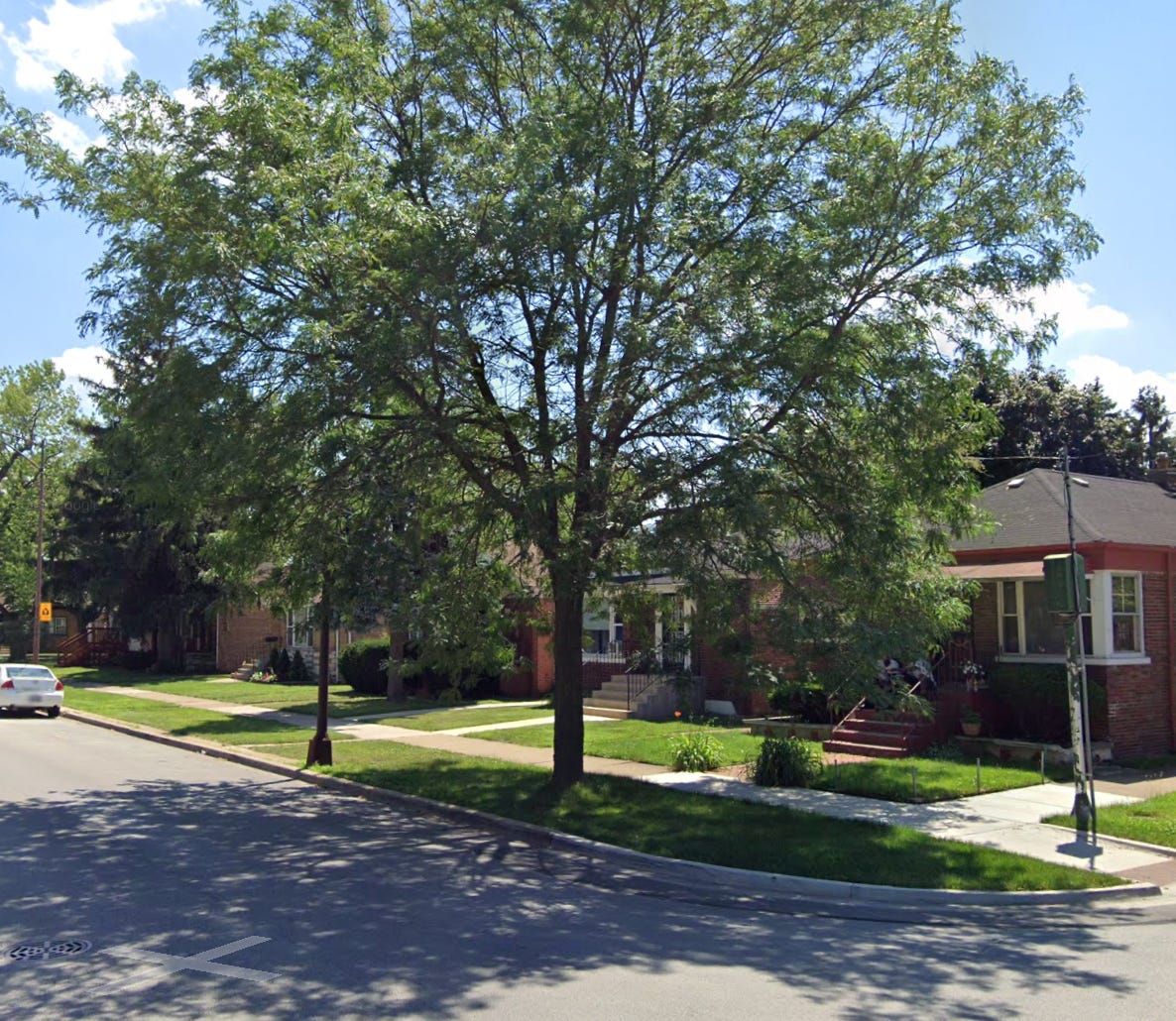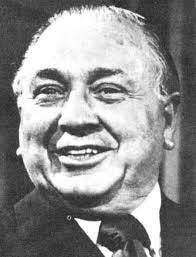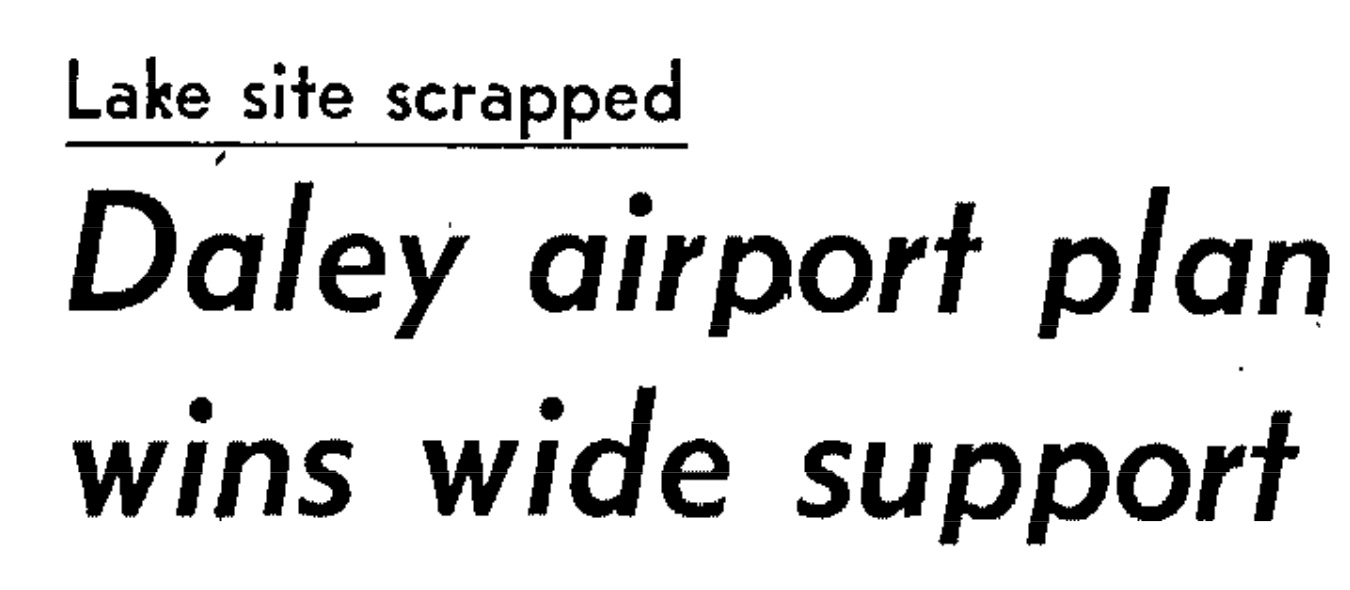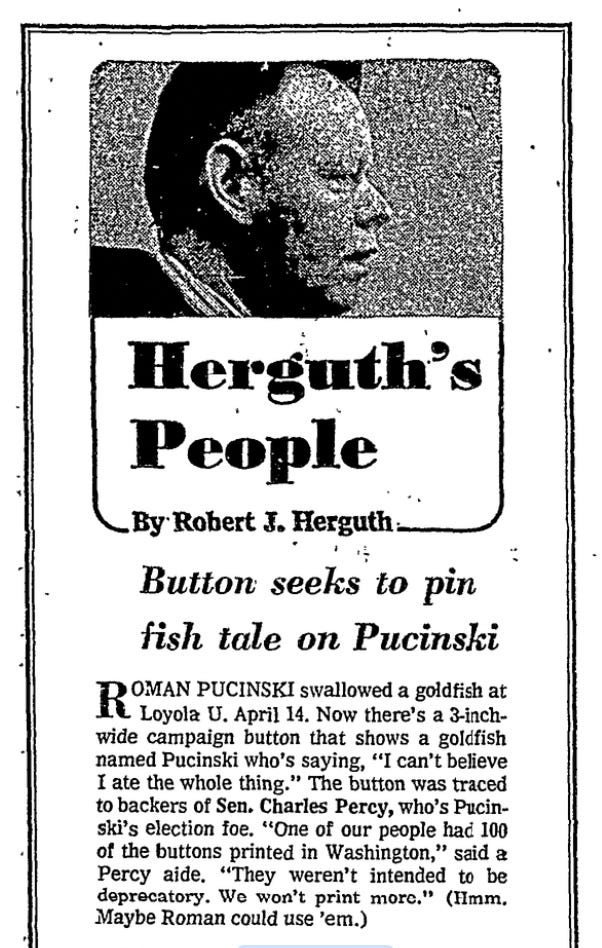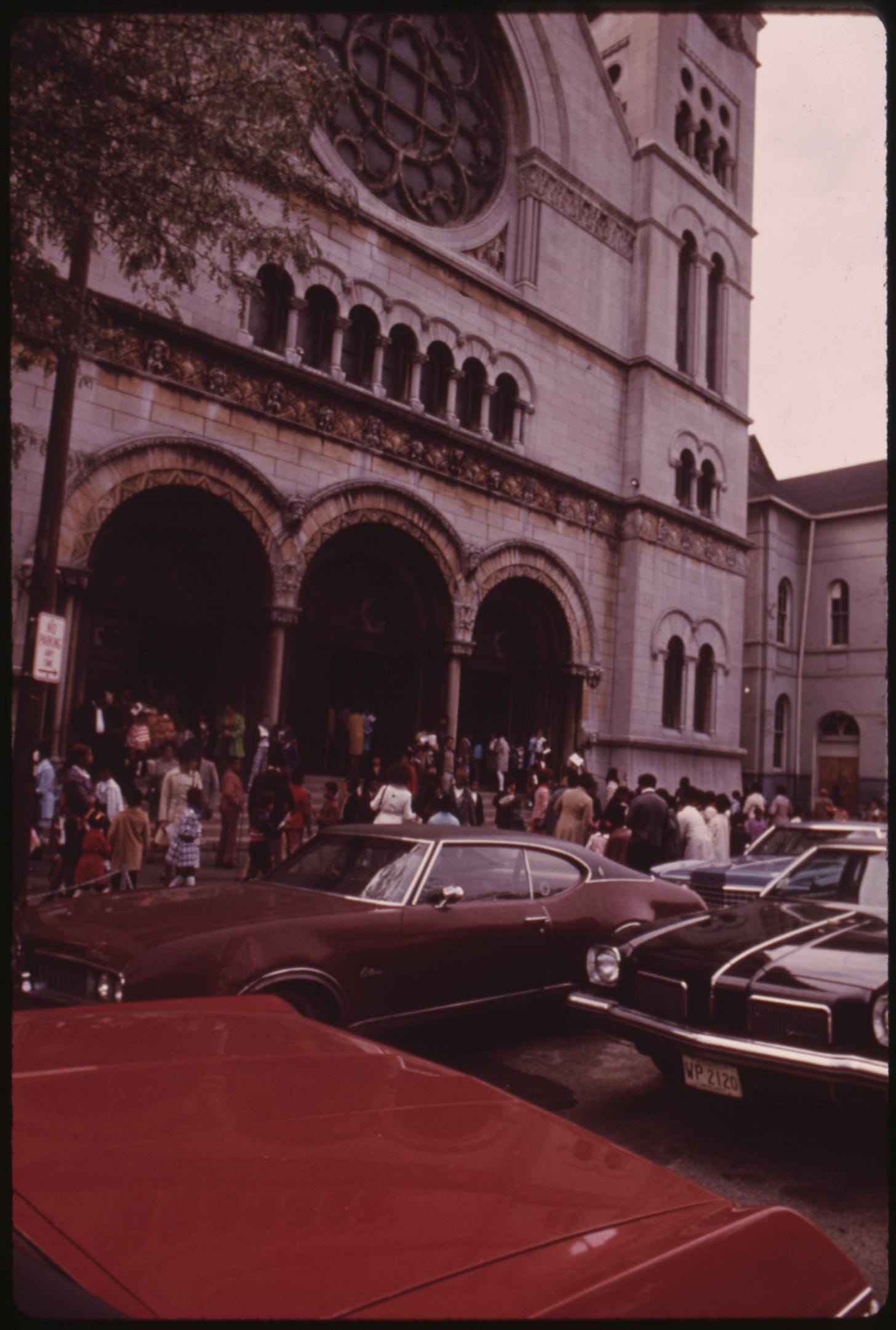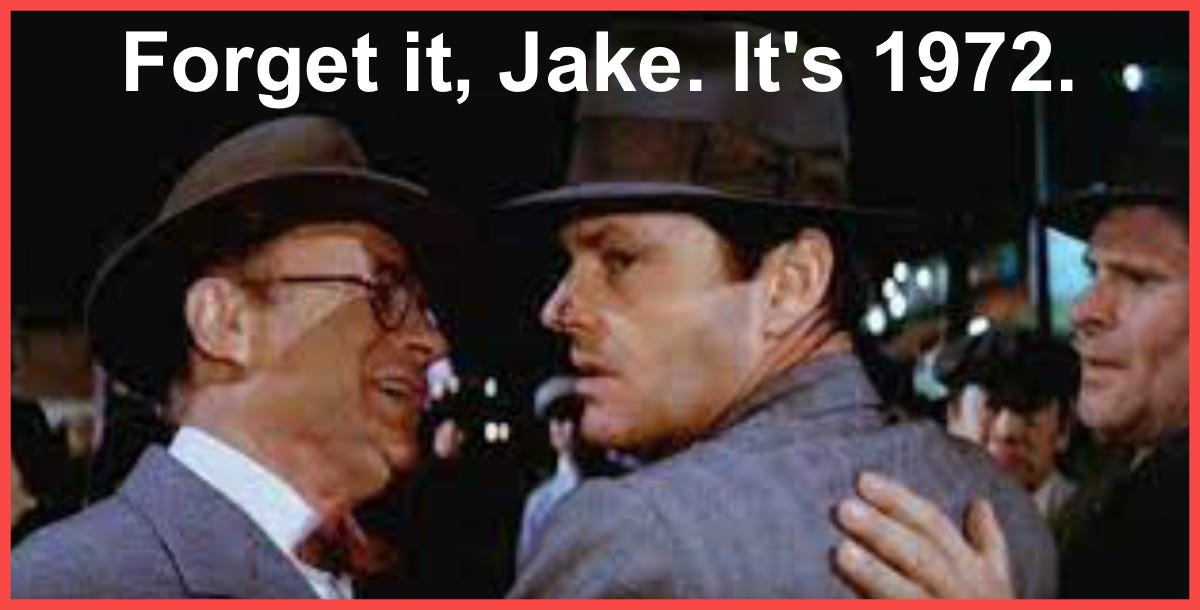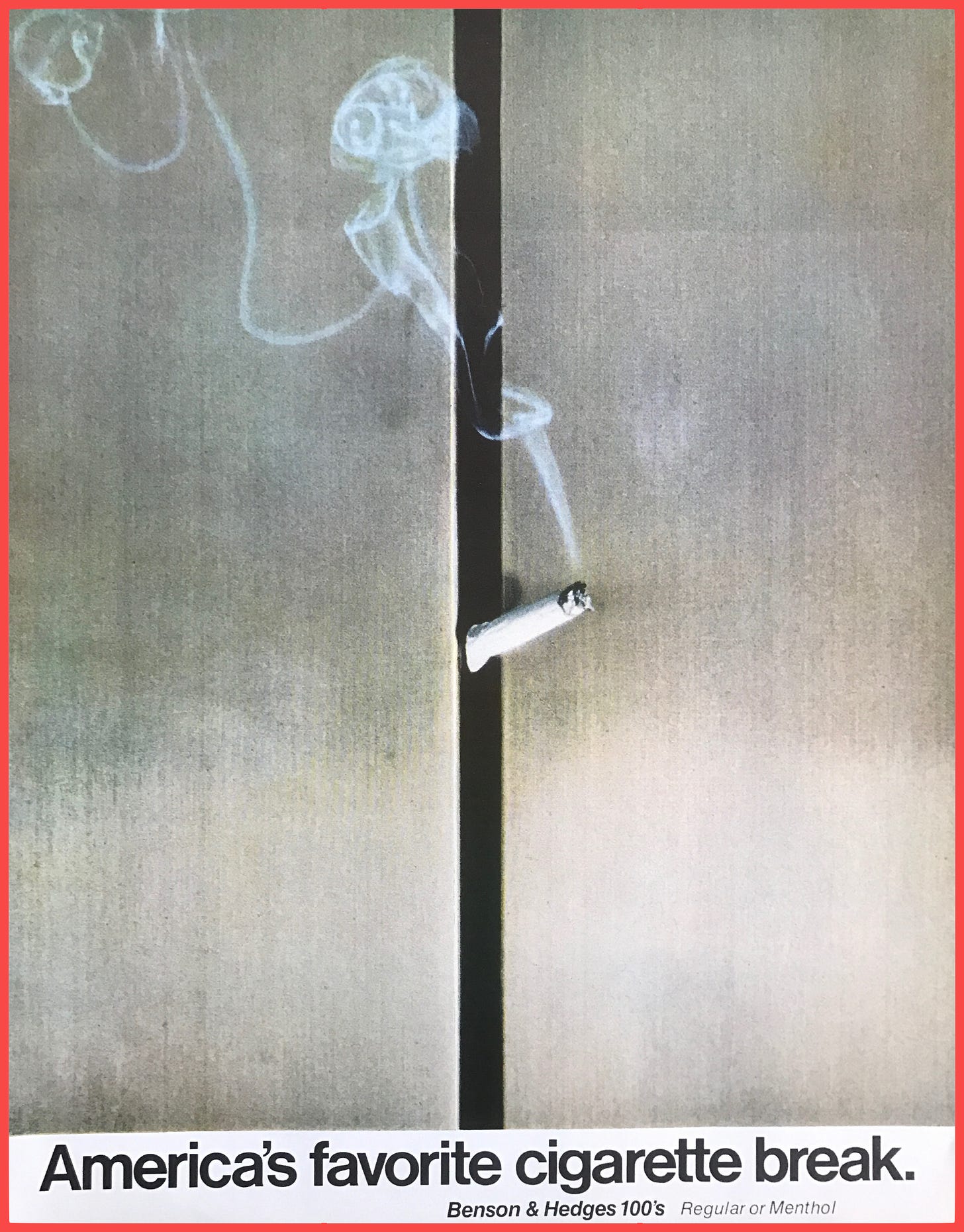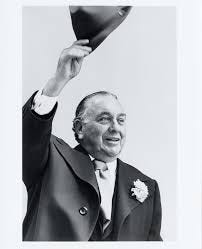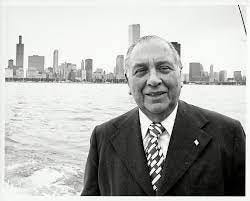THIS CRAZY DAY IN 1972: War, terror, and the first ATM machines
May 8-14, 1972
To access all contents, click HERE.
Why do we run this separate item peeking into newspapers from 1972? Because 1972 is part of the ancient times when everybody read a paper. Everybody, everybody, everybody. Even kids. So Steve Bertolucci, the 10-year-old hero of the novel serialized at this Substack, read the paper too—sometimes just to have something to do. These are some of the stories he read. If you’d like, keep up with the 1972 papers every day on Twitter, @RoselandChi1972.
May 8, 1972
Chicago Today: LaSalle Bank proto-ATM ad and Pullman Bank proto-ATM ad
Younger readers may be shocked that ATMs weren’t always around—how the heck did people get cash?—and Older Readers may be shocked that these were around as early as 1972.
May 8, 1972
Chicago Daily News: Ad for Channel 2 News 10 p.m. story
I wonder if Channel 2’s new “Super Anchorman” Bob McBride introduced this one? In any case, it’s always interesting to see how long society has worried about crowded, busy modern life driving everyone nuts. Much longer than 50 years of course, but here’s a 1972 example:
May 9, 1972
Chicago Daily News: Blockade is on!
President Nixon has just ordered the mining of North Vietnam’s Haiphong harbor, and among other things, “Antiwar demonstrators Tuesday tied up traffic on the Eisenhower Expressway, staged a sit-in at President Nixon’s downtown campaign headquarters and marched through the Loop.”
May 9, 1972
Chicago Daily Defender: Full page phonebook ad
No internet? No problem. Find people, and let people find you, with a book about a foot thick which will become the go-to example of something impossible to rip in half.
May 9, 1972: The Mighty IC
Chicago Tribune
by Cornelia Honchar
We usually follow the Citizens Action Program (CAP) as it opposes the Crosstown Expressway, sometimes with co-chairman Father Leonard Dubi coming close to a fistfight with U.S. Rep. Roman Pucinski. Today CAP is concerned about the IC’s plans to develop its vast acres between 12 Street/Roosevelt Road and 31st Street.

“The Citizens Action Program demanded yesterday that negotiations between the city and Illinois Central Industries, Inc., on plans for the development of air rights sites on the lakefront between 11th and 31t Streets, be opened to the public.”
Father Dubi’s co-chairman, Paul Booth, handles this one along with 16 other CAP members. Booth and colleagues met with Chicago Planning Commissioner Lewis Hill, “demanding that the negotiations be opened in compliance with the 1967 Illinois Open Meeting Act,” writes the Trib’s Cornelia Honchar. “The talks have been going on for several years.”
“We fear this land will turn into a high-rise city within a city, open only to those who can afford it, and the lakefront will be eaten up,” Booth tells Honchar. But the real point, he says, is that they don’t have access to the documents and meetings notes to see what the city has been privately planning with the IC for several years already.
Lewis Hill says the negotiations aren’t subject to the Open Meetings Act. CAP will have to wait until the city issue its guidelines for the 104 acre of lakefront to the city planning commission for review. The planning commission sends the guidelines to the City Council for approval.
CAP wants the Illinois Attorney General to sue the city to reveal its negotiations, but Assistant Attorney General Bernard Genis says nope. Genis says only State’s Attorney Ed Hanrahan can handle it, without explaining why.
May 10, 1972
Chicago Daily News: Life ends in rubble of Old Exchange he fought to save
by Larry Finley
Workers finally found the body of architectural photographer and preservationist Richard Nickel, “buried beneath tons of rubble in the ruins of the Old Stock Exchange Building, a landmark he knew and loved and fought to save.”
Richard Nickel disappeared on April 13, “swallowed up in the skeleton of the famous Adler and Sullivan building at 30 N. La. Salle.” After a vast movement to save the old Exchange failed, Nickel had been visiting regularly to save priceless architectural ornamentation as wreckers demolished the building.
It all started in the ‘50s, Finley recounts, when young photography student Nickel was assigned during a class at the Illinois Institute of Technology to photograph Adler and Sullivan’s Jeweler’s Building at Wabash and Madison. Nickel was hooked. The picture below is from a terrific post on Gerald Larson’s “The Architecture Professor” website including a bit on the Jeweler’s building.
In 1960, Richard Nickel essentially began the city’s architectural preservation movement when he started picketing in front of Adler & Sullivan’s Garrick Theater Building at 64 W. Randolph to stop its demolition. The Garrick wasn’t saved either, but Nickel got permission to photograph it, and to salvage its ornamentation.
As we’ve followed Nickel’s story here, we mentioned that he’d been working on a definitive book of Louis Sullivan’s work for 15 years. The book would be finally finished, beautifully, in 2010 by the Richard Nickel Committee. Here once more is a slightly worn copy of "The Complete Architecture of Adler & Sullivan" by Richard Nickel and Aaron Suskind with John Vinci and Ward Miller.
May 10, 1972
Chicago Daily Defender: From our readers
As I mentioned in Chapter One and the About page, 1972 is not a safe space. Sadly, that includes Roseland.
May 10, 1972
Chicago Daily News: I’m against lake airport, says Daley
by Jay McMullen
The end of Mayor Daley’s dream/environmentalists’ nightmare to build an airport eight miles off 55th street in Lake Michigan!
Suddenly, Mayor Daley says he’s “unequivocally” against the lake airport, or any third airport at all.
“The mayor said studies have shown that O’Hare Airport and Midway Airport can be expanded to take care of all foreseeable increases in passenger loads. Conservationists have vehemently opposed an airport in the lake, and a bill is now pending in the Legislature to outlaw one,” writes Jay McMullen, future husband of future Mayor Jane Byrne.
That would be state Rep. Robert Mann’s Lake Michigan Bill of Rights, which Daley adamantly opposes. See the April 15 item here for Mann’s dueling appearance at a City Council hearing on the lake’s future with Daley’s commissioner of development and planning.
Classic Mayor Daley! Eye on the political winds, he suddenly said last month that if a lake airport would be bad for the lake, he would reconsider his support. Now, he says city consultants have completed studies showing that Midway “can accommodate 180,000 operations a year,” plus airlines are using bigger planes and O’Hare can be expanded, so we’re all good.
Mayor Daley still insists studies are not conclusive on whether plopping a $1 billion airport in the lake would have negative consequences, but he says, “It is time we eliminated the emotionalism and controversy about this issue.”
Now, Daley has ordered a new plan for the lakefront, ready for submitting to the City Council in 90 days.
May 11, 1972
Chicago Today: Daley airport plan wins wide support
Since everybody but Mayor Daley’s flunkies were against Mayor Daley’s lake airport by now, everybody but everybody supports Mayor Daley’s sudden opposition to his own lake airport.
In today’s collection of reactions, you can tell some people are just ready to cry with relief.
Citizens Action Program co-director Paul R. Booth speaks the obvious—that Mayor Daley is reacting to public sentiment.
Others have a more selfish interest in shifting more flights to Midway rather than despoiling Lake Michigan.
“‘We’ve been waiting for this for four years,’ said Sam Miritello, owner of the Trade Winds restaurant and lounge at 58th Place and Cicero Avenue. ‘We’ve been dying on our legs. This is the greatest news the mayor could give us.”
I wonder if Sam Miritello made some good dough when his place got demolished for Midway expansion.
If you’re a regular THIS CRAZY DAY reader, you’ll probably want to follow Mike Royko 50 Years Ago Today too.
May 11, 1972
Chicago Today: N.U.’s demonstration of logic
By Jeff Lyon
President Nixon has just ordered the mining of North Vietnam's Haiphong Harbor. A new wave of anti-war demonstrations are sweeping the country, including a dramatic night in Evanston—despite Chicago Today’s uncharacteristically boring headline.
Today’s Jeff Lyon (who will join the Trib for a long illustrious career when Today folds) writes the heck out of this one.
“Antiwar activists of past years would have been drooling.
“The sumptuous mansion of a millionaire who has made much of his money thru defense contracts? The master away? His wife ill and unable to cope? A handful of suburban police guarding the estate?
“A piece of cake for the campus protester of 1968. All those beautiful windows in the home of Materials Service-General Dynamics tycoon Henry Crown waiting to be stoned, bushes to be trampled, cops to be stomped, a house to be thoroly trashed."
Let’s back up to how we got a mob of anti-war protestors at Henry Crown’s mansion.
“Thousands had gathered for a monster rally in Deering Meadow.” The crowd got “grass-stained and chilly,” but then revved up by “a scrawny history teaching fellow named Rich Klimmer…when he suggested marching peacefully to the 900 Edgemere Court home of Crown in Evanston.”
Almost 4,000 students charged to the dark brick mansion, writes Lyon. Just a dozen Evanston cops “stood on the lawn with nightsticks” as “reporters and the vanguard of the march showed up.”
The cops announced that Henry Crown was out of town, and his wife had a serious heart condition and would not be coming out to talk to anyone.

Then the rest of the crowd “thundered onto Lee Street, baying anti-war slogans like foxhounds.” A police captain announced there was a state law prohibiting trespassing on private property and “talked of how he could easily get reinforcements”.
The crowd hissed.
But “activist math prof” “Mike Marcus” perched on a brick gatepost and spoke:

“We seek to make our cause visible thru a student strike. But what you have in mind would mean only hurting a few police, having them hurt you, breaking 13 windows. Or maybe 94. Wow.
"Mrs. Crown apparently is sick. If this is so, I wish her life as I wish life for the Vietnamese. I imagine some of the police here are against the war, too, and if so, they have nothing to gain by beating you up. But they will.
“We have more important things to do than to allow ourselves to degenerate into petty vandalism,” Marcus “bellowed.”
Marcus called for a vote. Nobody was in favor of storming the mansion.
“The Evanston police captain was a little stunned by this squat math teacher who could sway thousands,” writes Lyon.
“‘One of the best jobs of crowd control I’ve ever seen,’ he said.
“He might have added it was one of the most controlled crowds he had ever seen as well. For the torch of fierce protest seems to be waning, at Northwestern and elsewhere.”
So already in 1972, college students were being compared unfavorably to '60s college students. The next forty years worth of college students know how that feels.
Prof. Michael B. Marcus would become a Guggenheim Foundation Fellow in 1993. Per his bio listed for a lecture, "His main mathematical interests are in Gaussian processes, probability in Banach spaces...and the interplay between additive functionals of Markov processes and Gaussian chaos processes."
May 11, 1972
Chicago Daily News: Herguth’s People
U.S. Rep. Roman Pucinski, currently in a rather hopeless race for the U.S. Senate against incumbent Republican Charles Percy, gets the first item in the daily gossip column by Daily News reporter Bob Herguth.
We last heard from Rep. Pucinski on April 24 as he threatened to punch a priest “right in the nose” during a raucous meeting outside his office regarding Mayor Daley’s remaining monster pet project, the Crosstown Expressway.
For Younger Readers: Where’s that phrase from—”I can’t believe I ate the whole thing”? In 1972, it was everywhere. And everybody knew it was from commercials for Alka-Seltzer. Here’s one from our year:
May 11, 1972
Chicago Today: Promo for upcoming Sunday article
At first glance, the headline suggests a nuanced article that explores how some people are cut out for parenthood, but maybe it’s not for everybody.
The summary sounds more like the presentation of Mary’s fate in “It’s A Wonderful Life” in the alternate world where George Bailey was never born.
Never-born George asks angel Clarence what’s happened to his wife, Mary, in this world without him. For the first time, rather than eagerly showing George awful visions of the world without him, Clarence blanches. “I’m not supposed to tell!” he declares desperately.
But eventually Clarence relents and tells George the worst news yet—worse than George’s Uncle Billy in an insane asylum after losing the Savings & Loan; worse than George’s younger brother drowning as a young child because George wasn’t there to save him.
“You’re not gonna like it, George,” says Clarence sadly. “She’s an old maid. She never married. She’s just about to close up the library!”
Having passed on marriage and entered into the secular convent of the library, Mary never learned how to pluck her eyebrows.
May 11, 1972
Chicago Daily News: Letters to the Editor
May 11, 1972
Chicago Daily News: Daley defends the police
by Robert Signer
Mayor Daley gives the opening speech at the 11th annual police recognition ceremony at Arie Crown Theater, and throws another monkey wrench in the ongoing controversy about police brutality especially in the Black community—see next item for how that’s going.
Robert Signer reports that Mayor Daley “apparently departed from his prepared remarks to say ‘we should indict’ critics of the department ‘for trying to tell us what’s wrong with the police department.’”
“‘I’m proud of our police department,’ Daley said, repeatedly pounding the edge of his right hand on the lectern as he spoke. ‘We have the finest of any in the world. We have no apology to make to anyone. We’re human.’” It reads like Mike Royko wrote it, but no, it’s real Mayor Daley.
Even though everyone agrees the state of police-community relations is at its lowest since the Summerdale police scandal—between police brutality allegations and various investigations that have recently resulted in indicting 12 active police officers—Mayor Daley declares Chicagoans should be “grateful to the Chicago Police Department for the great job they’re doing to keep order and respect in our community.”
Signer says there are “widespread reports” that Daley is “increasingly irritated” with Police Supt. Conlisk.
Nonetheless, Mayor Daley introduces Conlisk as “the man who has made everything the Chicago Police Department has achieved possible.”
May 12 and May 13, 1972
Chicago Daily Defender: CONLISK’S MEETING FLOPS
by Lucille Younger
Chicago Daily News: Oust Conlisk, blacks ask
by Lu Palmer and Diane Monk
Chicago Today: Angry blacks blast Conlisk at symposium
by Jeff Lyon
“The only way Supt. James B. Conlisk Jr. is going to get to the grassroots of the black community is to start from the beginning with U.S. Rep. Ralph H. Metcalfe and members of the Concerned Citizens Committee for Police Reforms,” writes Lucille Younger in the Defender.
“That was the resounding message he received Thursday night when more than 100 persons walked out of the first in a series of meetings planned by Conlisk and Mayor Richard J. Daley to begin a dialogue about mounting tensions between black people and police.”
Audience members started yelling remarks 15 minutes into the meeting, according to Younger, and after that it “was never the same despite threats by Fillmore District Commander Fred Rice who said that the meeting would be closed if order was not restored.” [NOTE: Fred Rice is a future Police Superintendent himself. Fun fact, I have a signed note from Fred Rice acknowledging the letter I wrote him praising two cops who reluctantly helped me change a tire at 87th and the Dan Ryan at about 2 in the morning when I couldn’t turn the damn lug nuts to get the flat tire off my car. They didn’t want to help, and almost left me there rather than giving me a hand turning the lug wrench. But I wrote them a glowing review to make them hopefully think twice about being more helpful to others in the future. This was before cell phones and power tools you could carry with you in the car to do this job, so it really was insane that the two cops had to be nearly forced to help me out.]
The audience wanted Conlisk to meet with Metcalfe and address the six demands he and other Black leaders presented at an April 24 meeting. (See the April 25th item here for details.) Chicago NAACP head Andrew Barrett called Conlisk “a goddam liar” when Conlisk claimed “he had tried to meet the six demands”.
Renault Robinson, executive director of the Afro-American Patrolmen’s League, maintained “a semblance of order,” writes Younger, when he “seized control of the microphones and pleaded with the residents to ‘At least listen to Conlisk. You do owe him that much.’”
Chicago Today’s Jeff Lyon (as always) gives us the best details:
“A frazzled, sweaty Police Supt. James B. Conlisk Jr. came out of last night’s meeting in the Fillmore district telling a reporter, ‘I don’t know what I learned, I’m so mixed up right now.’ He climbed wearily into his limousine in front of the Sears YMCA, 3201 W. Arthington St., as crowds of Lawndale residents hooted, ‘Good night, Chief Pig.’”
During the meeting, writes Lyon, “Conlisk stood motionless and unsmiling much of the time, only occasionally murmuring an answer.” Conlisk “apparently did not understand some of the lingo” and “any number of times inflamed the audience by having to ask a speaker to repeat his statement.”
Plus, Conlisk’s current reform plan doesn’t go nearly as far as Metcalfe’s six major demands. Metcalfe is calling for a Civilian Board in each district to review police brutality accusations, while Conlisk is offering a single civilian overseer for the entire city.
Conlisk “spent much of the time listening, nervously wiping perspiration from his mouth and forehead. He was alert, but too quiet for a crowd that wanted quick solutions.”
Per Lu Palmer and Diane Monk in the Daily News, there were “more than 600 persons jammed” into the YMCA gymnasium, and almost half stormed out. The Daily News focuses on Black leader responses after the meeting:
“Massive street demonstrations were threatened by black leaders if Police Supt. James Conlisk Jr. is not fired and if civilian review boards are not established by July 4.
“The warnings were issued Friday by Dick Gregory, comedian-activist, and Renault Robinson” at a press conference at Holy Angels Church, 607 E. Oakwood Blvd., which also included pastor Father George Clements and Russ Meek, president of Search for Truth Inc.
Robinson told reporters they agreed with Metcalfe’s six points, but that was “just a start”.

Have you read Chapter 3 Notes Part A? Highlights: A fun look at MAD Magazine and the history of Jays potato chips. Then, investigating the Enema Bandit brings us to one of the saddest chapters in Chicago history.
May 12, 1972
Chicago Today: Bill Jauss sports column
Bill Jauss hangs out with Harry Caray at the first place in Chicago where Harry hung his hat—Comiskey Park.
Classic 1972 Harry Caray, calling the game shirtless from behind a wooden table set up in the centerfield bleachers. Jauss hangs with Harry for a Wednesday afternoon game as the Sox win 7-0. As game time drew near, “Caray carefully checked his essential equipment: backless bench, plain wooden table, scorebook, box of corned beef sandwiches, engineer, mike, record book, and—of course—the cooler.”
The fans crowd close. Harry lets them speak into his mike to announce how they’d run the team if they had manager Chuck Tanner’s job, and many say they’d put Pat Kelly in centerfield. Harry leers at girls in hot pants, which is a fun not-at-all creepy colorful detail for Jauss’ column. It’s 1972 all right.
“The program went back to the studio for a moment, so Harry reached into the cooler at his feet and snapped the top off a can of the beer he plugs in commercials. He waved the can to some bare-chested law students who were cutting classes from the University of Chicago.
“‘Say,’ Harry cried, ‘you guys mind if I have a cold one? I owe it to myself. Now you know what I mean: You can’t beat fun out at the old ball park!’”
“…Harry’s people cheered and sloshed high their paper cups in a toast.”
May 12, 1972
Chicago Today: Hijacker’s jumpsuit found
Remember the Vietnam war vet who hijacked an Eastern Airlines jet last week and parachuted out somewhere over Honduras? The guy who got on board with two bush knives and left with, among other things, $303,000 ransom ($2,045,250 in 2022 money) and two cartons of Benson & Hedges cigarettes?
Honduran searchers found his parachute harness and jumpsuit on top of Mount Sorocon in northern Honduras. Locals say they saw a stranger sitting on the ground with a backpack and small suitcase, counting money. Then he disappeared into the jungle. At least he won’t run out of smokes.
There’s a $25,000 reward ($168,750 in 2022 money) for information leading to his capture.
May 12, 1972
Chicago Today: Federal guards will shoot to kill hijackers: Volpe
Secretary of Transportation John Volpe finally shows up in the 1972 hijacking stories sounding like Mayor Daley. Speaking to the National Press Club, Volpe says federal agents will shoot to kill hijackers when necessary—this in the wake of a shoot-out this week at the Tel Aviv airport when Israeli officers stormed a hijacked jet disguised as mechanics and shot the Arab hijackers. A good story, I know, but there just isn’t room for every hijacking here.
“This is one way to stop hijackers,” said Volpe.
May 13-14, 1972
Daley at 70: still a man in motion
by Jay McMullen
Mayor Daley’s birthday isn’t until Monday May 15, but he gave “an exclusive interview to City Hall press regulars on Friday,” writes Jay McMullen, “jokingly calling them his ‘best friends’ and predicting ‘they’ll have loads of gifts for me.’”
So all the papers write about Daley’s 70th birthday over the weekend.
According to McMullen, future husband of future Mayor Jane Byrne, Mayor Daley looked tan and rested after a Palm Springs vacation. Mayor Daley says he feels “just as well as if I was approaching 40” thanks to “exercise” and “doing something I like to do and having no vindictiveness toward anyone.”
Despite what McMullen terms a “bulbous waistline,” Mayor Daley claims to exercise at home, including “bag punching, bicycle riding, rope jumping, weight lifting, ball playing and brisk walking.” The mayor claims he has an exercycle.
Mayor Daley also has a healthy aversion to jinxing himself. He says his health is “excellent,” but he’s cautious: “All those guys who say they’re in excellent condition—that’s what happened to Ed Kelly (the late Mayor Edward J.). He dropped dead right outside his doctor’s office.”
Chicago Today: Daley’s fit as a fiddle at 70
No byline for some reason on this article, but a fun different take on Mayor Daley’s birthday press conference. According to this unnamed reporter, Mayor Daley’s “athletic revelation” that he supposedly rides an exercycle, lifts weights and whacks a punching bag every day at home “raised the eyebrows of veteran Daley-watchers, most of them too corpulent to lift much else.”
“His pink jowls notwithstanding, the mayor also claims that he regularly rides a bike, still plays a little baseball and likes to play football and basketball with his grandchildren.
“‘That’s how I keep in such great shape,’ Daley told astonished reporters.”
Chicago Tribune: Daley to Turn Vigorous 70
by Edward Schreiber
Schreiber repeats all the other stuff and adds that “The mayor will reach the City Hall” tomorrow on his birthday “about 8:30 a.m., debarking from his chauffeur-driven car and walking the last mile or so, as is his custom if the weather cooperates.”
According to Schreiber, “One reporter says that the greatest exercise he has ever known the mayor to indulge in—except for walking that last mile to City Hall, of course—was to walk into the steam room at the Lake Shore Club.”
“‘Is there going to be a reception for you tomorrow at City Hall?’ someone asked the mayor.
“‘Well, if you fellows arrange it,’ said Daley.
“Well, Mr. Mayor, if they won’t, Howard Miller surely will.”
Context: On April 21, Henry Hanson wrote in the Daily News about Mayor Daley starting his 18th year in office--including the mayor’s recent call to controversial rightwing radio host Howard Miller’s on Miller’s first day on WMAQ in the morning drive time slot.
Sample Howard Miller line that day: “Mister Mayor, it’s pretty early in the morning to ask anyone to be profound, although I’m inclined to think you’re profound 24 hours a day.”
May 13, 1972
Chicago Today: Movie play in pictures
A charming regular Chicago Today feature in which a movie is summarized via pictures of several leading actors.
Here, Charlton Heston shifts from his previous favored genres of biblical antiquity (“Ben-Hur,” “The Ten Commandments,” “Julius Caesar,” “The Greatest Story Ever Told” ) and science fiction (“Planet of the Apes,” “The Omega Man”*) to the current scourge of biblical proportions so unbelievable it should be science fiction—skyjacking.
Here is “Skyjacked” in three acts.
*Didn’t forget the iconic “Soylent Green,” but the world has to wait for that one until 1973.
May 13-14, 1972
Chicago Daily News: Lu Palmer column
Police brutality is a political issue, writes Lu Palmer in his weekly issue, which is clear from U.S. Rep. Ralph Metcalfe’s “leadership in the newly formed Concerned Citizens for Police Reforms”.
And yet, Palmer notes, it’s interesting that “the black community in Detroit has gone to court on the police brutality issue.” The suit, officially brought by the Labor Defense Coalition, which Palmer says is “a broad cross-section of Detroit’s black community with some white support,” is against defendants including Detroit Mayor Roman Gribbs, the police commissioner, and the city itself over a specific unit of the Detroit police department called “STRESS.”
STRESS stands for “Stop the Robberies, Enjoy Safe Streets.” “STRESS is a surveillance and decoy unit, the size of which is unknown,” writes Palmer.
The suit claims that “15 people have been killed by STRESS officers and at least nine others have been seriously injured.” It charges that “STRESS patrolmen provoke victims to commit the ‘alleged’ crimes and provoke some to flee from custody” and that some STRESS officers “intentionally shoot to kill some of the victims” even though it’s not necessary for arrest or the officers’ personal protection.
The suit asks for the STRESS unit to be disbanded. Palmer thinks the “outcome could have great significance for police brutality watchers all over the country,” including Chicago’s Concerned Citizens for Police Reforms.
“Even if the effort fails, this could be an excellent vehicle to place on the record and in open court the details of several documented cases of brutality of which there are hundreds, perhaps thousands,” Palmer concludes.
“Police brutality, particularly against blacks and the poor, has become institutionalized. It is going to take every conceivable kind of pressure to eliminate it.”
May 13, 1972
Chicago Daily News: Letter to the Editor
Joy Savides of Park Forest continues her string of appearances in Chicago newspaper letters columns.
Her original letter in the News on April 24 (which also ran in Chicago Today):
Chicago’s Laurie Lemel responded in the Daily News last weekend:
And this week, Joy Savides swings back:
May 13, 1972
Chicago Daily Defender
This is the Defender’s first and only coverage of the dramatic story of Harold Drumm, whose dramatic story covered the front pages of the other dailies for the first two weeks of April after he got his arm cut off while playing in a trash compactor behind a South Side Zayre, then ran all the way home clutching his sleeve and told his Mrs. Drumm, “Don’t worry Mommy, I’ll be all right.”
We’ll discuss the Defender’s apparent policy of covering injured/missing/ murdered white children next week, here.
May 14, 1972
Chicago Today: Mary Knoblauch on Films
Film critic Mary Knoblauch scoffs at all the people who are currently tsk-tsking because audiences cheer “the grisly deaths of gangsters” in the current national blockbuster “The Godfather.”
She figures they just can’t remember when they were kids at a Saturday afternoon movie matinee cheering “when that guy in the black hat finally bit the dust.”
Knoblauch knows people who object to “Godfather” cheering will say, “Oh, you didn’t see his eyes popping as he was strangled or the holes blasted in his face by bullets” in the old movies. But, she points out, the characters were just as dead.
Knoblauch went to see “The Godfather” again recently and “a good part of the audience laughed when Michael lied to his wife at the end of the film about killing his brother in law.”
“That, to me, is much more worrisome than the cheering, because it means the whole point of the film has just passed them by,” she writes.
Toward the end of this long essay, Knoblauch circles back to that point to conclude:
“When Michael tells Kay that he had nothing to do with Carlo’s death, and people laugh, because he has conned her, they are laughing at themselves. One way of looking at ‘The Godfather’ is an allegory of the United States in that period. Big business, big unions and big government ran the country, for better or worse, for richer or poorer, while their wives, the citizens, dressed well, lived comfortably and never had to worry (or cared to worry) about the way that business was conducted.
“Today, like Kay, we are beginning to face the fact that what goes on behind that closed door of her husband’s office may be our responsibility, too.”
Did you dig spending time in 1972? If you came to THIS CRAZY DAY IN 1972 from social media, you may not know it’s part of the novel being serialized here, one chapter per month: “Roseland, Chicago: 1972” —FREE. It’s the story of Steve Bertolucci, 10-year-old Roselander in 1972, and what becomes of him. Check it out here.



